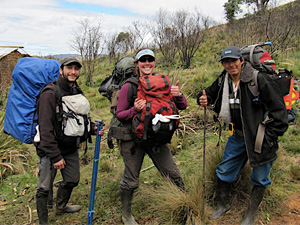New publication analyzes the production and management of environmental services in Ecuador's páramos
 |
(17 March 2015) Fundación Cordillera Tropical reports that researchers Carol Harden (University of Tennessee), Kathleen Farley (San Diego State University), Leah Bremer (Stanford University, California) and James Hartsig (University of Tennessee) have published the results of their study investigating the synergies and trade-offs of managing páramo landscapes for the production of multiple ecosystem services in Ecuador. The report written in Spanish summarizes how land use changes in the páramo affect (i) above and below ground carbon storage; (ii) soil water properties; and (iii) plant biodiversity.
The team conducted its research at the Mazar Wildlife Reserve (Cañar Province) and in the community of Zuleta (Imbabura Province). They studied the production of environmental services in 15 unique páramo land uses, examining the effect of afforestation with pines (Pinus patula) and Polylepsis (P. racemosa), and different burn histories.
The results represent some of the first empirical data about the production and management of multiple environmental services and suggest that best management practices for páramo landscapes depend on your conservation objective. For example, the team reports greater plant diversity and an increase in soil carbon capture in areas with infrequent burning (every 15 to 20 years). However, they also show that the páramo has greater water retention capacity in recently burned areas.
The scientists conclude that, ¨the differing relations found between the two study areas highlight the heterogeneity of Andean páramo ecosystems and the consequent difficulty of operationalizing recipes for land use that seek to maximize environmental services in the region.¨
To access their Spanish-language report:
Harden, C., K. Farley, L. Bremer, y J. Hartsig. (2015). Informe: Servicios ambientales ecosistémicos y cambio en el uso de suelo en el páramo. Universidad de Tennessee, Knoxville, Tennessee; Universidad Estatal de San Diego, San Diego, California; Universidad de California, Santa Barbara.
To access all project publications in English:
 |
|
Bremer, L.L., K.A. Farley, D. Lopez-Carr, and J. Romero. (2014). Conservation and livelihood outcomes of payment for ecosystem services in the Ecuadorian Andes: What is the potential for 'win–win'? Ecosystem Services 8:148-165.
Bremer, L.L. (2012). Land-use change, ecosystem services, and local livelihoods: ecological and socioeconomic outcomes of Payment for Ecosystem Services in Ecuadorian páramo grasslands (Doctoral Thesis). San Diego State University and University of California, Santa Barbara, California.
Farley, K.A., Bremer, L.L., and Harden, C.P., and J. Hartsig. (2013). Changes in carbon storage under alternative land uses in biodiverse Andean grasslands: implications for payment for ecosystem services. Conservation Letters 6:21–27. doi: 10.1111/j.1755-263X.2012.00267.x
Harden, C.P., Hartsig, J., Farley, K.A., Lee, J., Bremer, L.L. (2013). Effects of land-use change on water in Andean páramo grassland soils.Annals of the Association of American Geographers,103:2, 375-384.
Hartsig, J. (2011). The Effects of Land-Use Change on the Hydrological Properties of Andisols in the Ecuadorian Páramo (Master's thesis). The University of Tennessee, Knoxville, Tennessee.
The Fundación Cordillera Tropical is dedicated to generating knowledge about mountain ecosystems. We invite your proposals for collaboration.
